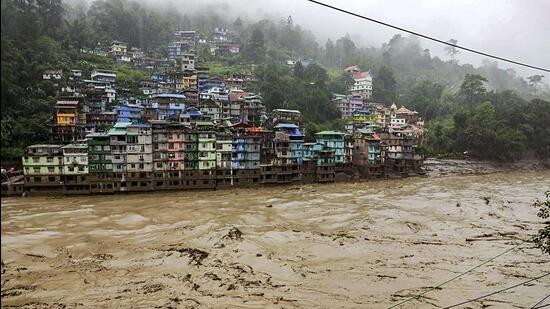Looming tragedy: Sikkim lake that overflowed in 2023 was unstable for years, new study finds
The flood devastated the Teesta Hydroelectric Project Stage-III (1200 MW), washed away the dam and flooded the underground powerhouse.
New Delhi: A new paper on the 2023 Glacial Lake Outburst Flood that killed nearly 100 people in the northwestern part of Sikkim has revealed the magnitude of damage a GLOF can trigger. It also found that the surroundings of the South Lhonak lake have been unstable for a long time revealing that such an event was waiting to happen.

The paper, published in journal Science on Friday states that part of the lateral moraine that collapsed into the lake was unstable and was showing maximum displacement of more than 15 m per year between 2016 to 2023, years before the actual collapse. “This finding shows that the surroundings of the South Lhonak Lake have been unstable now for a long time,” the authors of the paper said in a statement.
“On 3 October 2023, a multi-hazard cascade in the Sikkim Himalaya, India, was triggered by 14.7 million m3 of frozen lateral moraine collapsing into South Lhonak Lake, generating a 20 m tsunami-like impact wave, breaching the moraine, and draining ~50 million m3 of water,” reads the abstract of the paper by 34 authors including climate scientists, geographers, glaciologists, geologists.
“The ensuing Glacial Lake Outburst Flood (GLOF) eroded ~270 million m3 of sediment, which overwhelmed infrastructure, including hydropower installations along the Teesta River. The physical scale and human and economic impact of this event prompts urgent reflection on the role of climate change and human activities in exacerbating such disasters,” it adds.
The authors also found out that the South Lhonak Lake and its surroundings has permafrost (frozen ground).Warming permafrost can be a reason for the instability that caused the collapse, they said.
The flood devastated the Teesta Hydroelectric Project Stage-III (1200 MW) being developed by Sikkim Urja Limited , washed away the dam and flooded the underground powerhouse, leading to halting of operations.
The 3 October 2023 GLOF highlights the challenges in GLOF and multi-hazard assessments, which often fail to account for the intensity of impacts in mountain regions, where downstream geomorphic systems exacerbate the hazard. In this case, the GLOF’s severity was worsened by climate warming effects and heavy rainfall prior to the event. Current GLOF models fail to adequately consider sediment release and riverbank collapses, leading to potential underestimation of flood risks.
The event underscores the urgent need for enhanced early warning systems across the Himalayas to improve hazard detection, response, and reduce the impact of future GLOFs on communities, infrastructure, and agriculture, the authors said.
“As we work to reduce the risks of GLOFs in the Himalayas, it is clear that we need a multi-faceted approach, including early warning systems, strengthened regulatory frameworks, a paradigm shift in GLOF modeling approaches, and robust preparation programs and community education,” said Ashim Sattar, lead author, School of Earth, Ocean and Climate Sciences, Indian Institute of Technology, Bhubaneswar.
Other authors include Dan H. Shugar, University of Calgary; Dave Petley, School of Environmental Sciences, University of Hull, UK; and Anil V Kulkarni from Indian Institute of Science.
The study employed high-resolution satellite imagery to identify and map numerous landslides that were triggered by the GLOF event along the valley. The study also quantifies that 200 buildings and sections of Highway NH-10 (~6.4 km of road length) damaged at multiple locations by these landslides.
HT reported on January 27 that Expert Appraisal Committee of the Union Environment ministry has given a go-ahead to major design changes in the Teesta III hydropower project which will help the project reopen.








